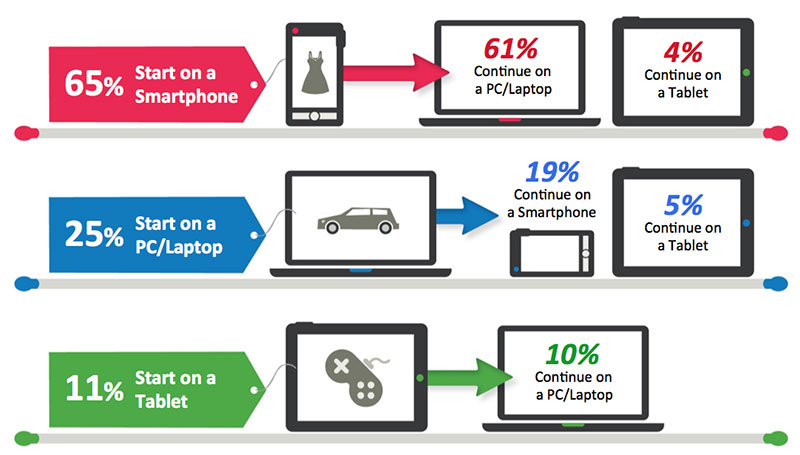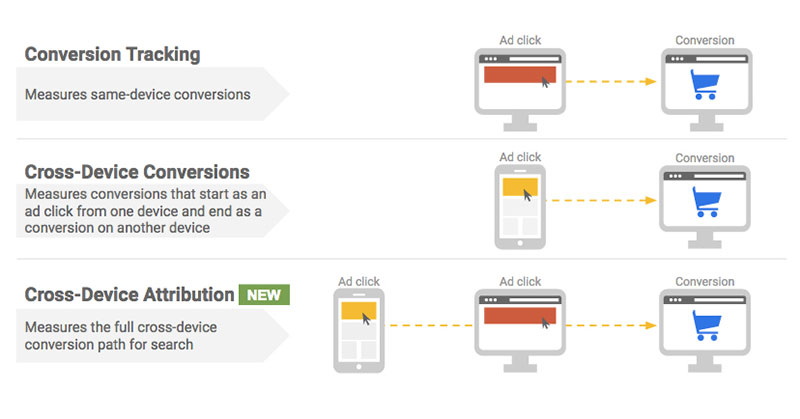Why cross-device attribution is important and you should use it

Online marketing is not only a profession, it is an art. Today’s marketers have to do much more than simply running marketing campaigns.
The true value of a marketer is reflected in his/her capability to analyze results. Advertisers need to understand the different channels that bring traffic to a site. Thus, they can optimize the budget and get a better outcome.
21st-century marketers have endless tools available. This is an advantage but can also be a disadvantage. While they have access to many resources, it becomes harder to understand which marketing channels are bringing real value to a business.
The fact that people are using multiple devices for their daily online activities, makes this endeavor even more difficult.
Cross-device attribution has become a vital resource to assess a campaign’s performance. The same user can find an ad on one device, then take the following steps using their tablet, and finally finish the purchase on a laptop.
This article presents the benefits of tracking a person’s activity through different devices.
Definition of cross-device attribution

Today’s market presents opportunities like never before, but it also brings a high degree of complexity. This is why it is necessary to track cross-device activity.
Cross-device attribution studies a person’s behavior across different mobile devices. It helps to track a conversion path from the moment a person finds the ad till the moment when he/she places the order.
A customer may use multiple platforms to make a purchase or hire a service. These may include a desktop computer or a mobile device and different channels like social media and email.
By analyzing these conversion paths, businesses can understand their clients’ behavior and optimize their marketing efforts.
This cross-device process can take place through different devices:
- Personal computers
- Smartphones
- Smart TVs
- Tablets
Only two decades ago, marketers’ work was much simpler. Most people had access to only a desktop computer. Thus, if a site had 500 visitors, analyzers could conclude that these 500 people were unique visitors.
Now, there is easier access to tablets, phones, laptops, and other devices. Every potential customer has access to at least a couple of these gadgets. Hence, it is harder for marketers to understand how many unique visitors a site has. The use of multiple devices throughout a conversion path presents a challenge for marketing professionals.
Cross-device attribution reports allow an advertiser to track different devices and identify them with the same user. Thus, it is possible to create a user’s profile, understand his/her behavior and create targeted marketing campaigns.
The essence of cross-device attribution is to attribute one single conversion path to different devices.
The advantages of cross-device attribution

An advertiser needs to properly assess a campaign’s performance to optimize results and manage the budget.
Every business needs to invest a fair amount of money to have an online presence, attract traffic and boost their products. Hence it is important to decide exactly what funds to allocate and where. Advertisers can run a variety of Facebook, Instagram, Twitter, and Google ads. They can even choose their targeted audiences and stipulate minimum and maximum spending.
When running a campaign, advertisers have a wide range of options to make. By analyzing cross-device conversions, they can make the right choices and optimize the expense/profit ratio.
Cross-device attribution helps to overcome today’s challenges. This tool integrates the different paths a customer takes when visiting a site or placing an order.
Cross-device attribution options
Thanks to this tool, marketers can:
- Drive users to high-conversion platforms. Marketers can analyze a person’s profile and behavior across different devices. Then, they can lead them to those places where they’re most likely to buy.
- Measure true ROAS and LTV. This helps you understand your users’ lifetime value. Thus, you can estimate the profitability of your marketing budget.
- Create a continuing message. When you understand a conversion path through different mobile devices, you can create consistent messages. Send your customers different messages across devices and create relevant communication.
- Prevent duplication. Siloed ads lead to reputation damaging, overexposure, poor engagement, and waste of resources.
- Make efforts count. Cross-device attribution provides a holistic view of the marketing process. It helps a business achieve more conversions.
Generally, the user doesn’t make a transaction the first time he/she sees an ad. There is a whole journey between the first contact and the moment when the user makes the desired action (buy, subscribe, download, etc.)
To accompany the user in this journey, advertisers can use three different types of campaigns:
Upper-funnel campaign: This campaign mostly involves video ads.
Mid-funnel campaign: These are ads on websites and mobile devices which users can respond to.
Retargeting campaigns: These are created for the user to make a transaction.
Through these approaches, conversion may happen in any of the user’s multiple touchpoints. These can be Google search, ad response, or retargeting.
By using cross-device attribution reports, advertisers can analyze these touchpoints. Hence, they can understand exactly when the lead was converted and what tool throws better results.
Cross-device attribution brings advantages to customers as well. An online shop uses gathered data to create a targeted marketing campaign and increase sales. So, customers have access to promotions and ads featuring their interests.
Utilizing resources such as device fingerprinting and cookies can be useful in creating personalized campaigns. However, this strategy needs to be carefully designed. It is important to consider current privacy regulations like CCPA (California Consumer Privacy Act). Advertisers should be ready to provide information if requested. They should include opt-in and opt-out options in every campaign.
This creates a reliable environment where providers, marketers, and customers can receive benefits.
We can help you turn your idea into reality, take over your existing project, or extend your current development team.
Schedule a free consultation at hello@tms-outsource.com, or fill out the form and we will follow up with you shortly.
Cross-device attribution: how does it work?
How does cross-device attribution work? How to follow a person’s journey across the web and through separate mobile devices?
The success of this approach relies on the tracking of a laptop, phone, tablet, or any other device to identify a user. Thus, experts can draft a person’s profile and predict their behavior.
There are two ways to identify a user through cross-device activity: Deterministic and probabilistic matching.
Deterministic matching
This approach is mostly used by large platforms like Twitter and Facebook. It is based on the comparison of different pre-defined variables: IP addresses, phone ID, email, and other device data.
A clear example of deterministic matching is the email address. A person doesn’t use a Gmail account only for sending and receiving emails.
The web is plagued with plenty of free software and resources for a reason: registration. Many people use a Facebook or Google account to create a profile or log in to a platform. Thus, no matter what device they are using it is possible to track them.
Probabilistic matching
This approach is based on probability. There is a piece of code (usually JavaScript) that collects information from the device.
This information is compared with a database of profiles and analyzed according to different algorithms. Thus, the system creates a digital fingerprint for a device.
Probabilistic matching tracks the following parameters:
- Language settings
- IP addresses
- Location
- Device ID
- Interests
- Web history
- Browser settings
- Operating system
This option avoids legal privacy issues because it tracks the device’s information. This is anonymous data. Probabilistic matching offers a fairly clear picture of the conversion point.
Hybrid options
In some cases, it is possible to use both methods in different parts of the process. You can use data from partners for a deterministic approach albeit matching is only probable. You can also use a deterministic approach to complement your probabilistic-based strategy. Thus you can achieve more accurate results.
The importance of cross-device attribution
The world is full of online and offline consumers connecting to brands in different ways. As technology develops, the market grows in complexity. In this context, probabilistic and deterministic matching are useful tools.
Cross-device attribution is an excellent solution for 21st-century advertisers. This will never be a perfect tool yet it can be improved.
Marketing campaigns based on data collection can be very effective but it is important to consider the updates in privacy laws. These will stipulate what information can be collected with or without consent, and what information cannot be collected at all.
But where to store all this data? How to sort it? The increasing need for cross-device attribution reports is creating a demand: the data-management platforms.
Thanks to these, marketers can organize and activate information from different channels and devices. They can understand their audience and create more effective advertising campaigns. All in all, this is a great tool for leading users across different devices until conversion.
Looking for a development partner?
If you’re looking for a technology partner, development team augmentation, or just a company for your software&app development initiatives, consider TMS.
TMS is a software and digital company in Belgrade, Serbia. We develop innovative and modern software.
A few examples include premium booking software Trafft, MedTech apps like MR Prepare, or MarTech/AdTech apps like the Advise Media Suite, among other great software examples.
Check out our services and also some of the work we’ve done for our clients. Who knows, maybe we’ll form a successful relationship.
Schedule a free consultation at hello@tms-outsource.com, or fill out the form and we will follow up with you shortly.
If you enjoyed reading this article about cross-device attribution, you should check out this one about what is AdTech.
We also wrote about a few related subjects like behavioral targeting, MVP tests, personalization algorithms, how to hire a web development team, software development budget, financial projections for startups, financial software development companies, proof of concept vs prototype, and what is MadTech.

